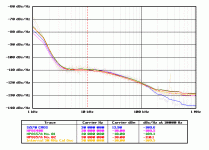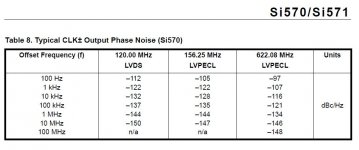actually it seems there is a problem for some of us that I havent seen mentioned specifically: to use a clock that is high speed enough to do 8x OS + sync mode with ESS and >176/192+kHz we have the NDK crystals in 90.x/98.xMHz. this will allow 8x OS sync mode on these hirez formats, but the same XO will not support the lower speeds like 44.1/48kHz audio. it wont support it because there is no 2048x mode on fifo, so you would have to change clocks.
the only viable option are things like the Silicon labs Si570/571 which will change speeds on the fly as well as being very low jitter.
I guess not many people thought this through, because Ian posted an interest thread for a clock board using these and only a few people replied. to me its the only way forward.
happy to be told i've missed something
the only viable option are things like the Silicon labs Si570/571 which will change speeds on the fly as well as being very low jitter.
I guess not many people thought this through, because Ian posted an interest thread for a clock board using these and only a few people replied. to me its the only way forward.
happy to be told i've missed something
Last edited:
Silicon labs Si570/571 isn't a solution because is not low phase noise where it matters, at low frequencies. And, more than that, it requires a processor in order to be programed which is another source of noise.
i'm well aware it needs a controller, so does the whole fifo so its hardly an argument. it (and others like it) are the ONLY solution unless you want to change clocks physically, unless Ian enables a 2048x mode. I welcome other solutions, but sorry I pay no attention to those who mention 'issues' without offering an alternative.
I would think the measures of the Si570 already include the noise from the controller, not sure how they could possibly measure it without it's controller …
Last edited:
This is the alternative:
http://www.crystek.com/crystal/spec-sheets/clock/CCHD-957.pdf
+2048x mode in FIFO
http://www.crystek.com/crystal/spec-sheets/clock/CCHD-957.pdf
+2048x mode in FIFO
Last edited:
If I remember correctly 2048x in FIFO needs additional memory that won't be available in the current format. Possible with multichannel FIFO if Ian has time to develop such a beast while snowed under with orders for the current device 
Also, AFAIK, the Si570 only requires controller while switching frequencies, not during 'normal' operation.
EDIT: I may have confused post 783 and 784 from the main thread in coming to the conclusion I have above about 2048x mode.
Also, AFAIK, the Si570 only requires controller while switching frequencies, not during 'normal' operation.
EDIT: I may have confused post 783 and 784 from the main thread in coming to the conclusion I have above about 2048x mode.
Last edited:
Also, AFAIK, the Si570 only requires controller while switching frequencies, not during 'normal' operation.
True! But one should disable the controller itself during normal clock operations.
This can be done, but I have to repeat myself: Si570/571 is't low phase noise at low freq
payment done
#1,2,3,4,5,7,8,10,11,12,18,21,22,23,24,25,26,#27,30,31,32,34,35,36 ,38,40,42,43, 45,46,47,48,49,50.
Invoices were sent to your Paypal account email addresses. Please let me know if you don't receive. Got all of the assembled PCBs from SMTA factory. I spent the whole weekend doing the loop test. Everything will be ready for delivery by next week.
Thanks
hirez69
#1,2,3,4,5,7,8,10,11,12,18,21,22,23,24,25,26,#27,30,31,32,34,35,36 ,38,40,42,43, 45,46,47,48,49,50.
Invoices were sent to your Paypal account email addresses. Please let me know if you don't receive. Got all of the assembled PCBs from SMTA factory. I spent the whole weekend doing the loop test. Everything will be ready for delivery by next week.
Thanks
hirez69
sorry I had to run out, regretted the wording while I was out. I didnt mean it as stern as read, just gets to me a bit when people pick holes in a solution without providing a viable alternative. do remember due to its nature the PSRR will be very good and the low down phase noise is hardly bad. lets move it to the thread proper anyway rather than here
edit: Roender, the crystek is only available in those frequencies with a large bulk order, not single pieces. i'm already using the 45.1584MHz and as mentioned it would need a change to the fifo.
quad clock board anyone?
edit: Roender, the crystek is only available in those frequencies with a large bulk order, not single pieces. i'm already using the 45.1584MHz and as mentioned it would need a change to the fifo.
quad clock board anyone?
Last edited:
edit: Roender, the crystek is only available in those frequencies with a large bulk order, not single pieces. i'm already using the 45.1584MHz and as mentioned it would need a change to the fifo.
quad clock board anyone?
;-)
Crystek CCHD-957 Series Standard Clock Oscillators | Mouser
and?… where is this 90.3168? like I said I already have 45.1584MHz. its the 90.3168/98.304MHz thats rare, with only the NDK as a standard part. then we face the current lack of 2048x mode. A quad XO board, or a clock that can switch speeds on the fly is what is needed to handle the full 44.1/48->352.8/384kHz sampling rate range.
I have to be clear for those who are reading, its only if you want the full 352.8/384kHz capability while maintaining the 44.1/48kHz that you have a problem; the 176.4/192kHz speeds are well catered for as is.
of course there is another solution; I/we can use puremusic or similar to upsample the 44.1/48kHz content before the signal is sent.
I have to be clear for those who are reading, its only if you want the full 352.8/384kHz capability while maintaining the 44.1/48kHz that you have a problem; the 176.4/192kHz speeds are well catered for as is.
of course there is another solution; I/we can use puremusic or similar to upsample the 44.1/48kHz content before the signal is sent.
Last edited:
This is the measured phase noise of SI570 extracted from here: Si570 Kit from K5BCQ
IMHO, not suitable for audio
IMHO, not suitable for audio
Attachments
funny that its already been used pretty successfully in audio. all clocks get worse as the frequency goes down and the crystek is no exception, the crystek is an extraordinarily good XO and has quite a bit better performance down low. It does not come in suitable speeds to solve the very particular problem i've been talking about since the post on the previous page, a problem you have not offered an alternative for. we all have access to the datasheet, posting excerpts from it tells me nothing the thread (anyone whos interested enough), myself or Ian dont know
now unless you are going to post an actual alternative, please leave it alone and do not post on the subject again. I shouldnt even be replying, you are free to not use it.
now unless you are going to post an actual alternative, please leave it alone and do not post on the subject again. I shouldnt even be replying, you are free to not use it.
Last edited:
funny that its already been used pretty successfully in audio. all clocks get worse as the frequency goes down and the crystek is no exception, the crystek is an extraordinarily good XO and has quite a bit better performance down low. It does not come in suitable speeds to solve the very particular problem i've been talking about since the post on the previous page, a problem you have not offered an alternative for. we all have access to the datasheet, posting excerpts from it tells me nothing the thread (anyone whos interested enough), myself or Ian dont know
now unless you are going to post an actual alternative, please leave it alone and do not post on the subject again. I shouldnt even be replying, you are free to not use it.
Would you please specify where is used? In which project here at diyaudio or elsewhere?
Please compare it with this:
XO
or, from the same manufacturer but dedicated for audio:
http://www.crystek.com/crystal/spec-sheets/clock/CCHD-957.pdf
My point is clear: si570/571 proposed by you isn't suitable for audio. It is just a generic XO with a variable output frequencies.
The alternative is to have a FIFO with software able to accept all DSD and PCM formats. There is something in this forum able to do that but from other perspective - SDtrans384
This doesn't means that this project isn't valuable. It's beautifully conceived but not complete (IMHO)
Last edited:
Ian,
Sorry for not reading all the specs when I put myself on the waiting list for FIFO, Dual XO and SPDIFF interface, but I have to pass this GB now.
Kind regards,
Mihai
Thanks Mihai for letting me know. You can quit GB II I don't have problem. Come back at any time to me if you want.
Regards,
Ian
This is the measured phase noise of SI570 extracted from here: Si570 Kit from K5BCQ
IMHO, not suitable for audio
Hi Mihai,
Just a kindly discuss with you. I saw that phase noise plot long times ago. But I don’t know if you noticed the testing condition. The guy did the test by a R3463 spectrum analyzer , not a phase noise analyzer. He clearly mentioned that he had limitation on close-in phase noise measurements. That means the close-in phase noise result was not accurate. However the Si570 phase noise floor won all other reference oscillators which was true. So, I list the link of where the plot originally came from just in case there was any misleading by it.
http://www.cliftonlaboratories.com/si570_kit_from_k5bcq.htm
I attached the rated phase noise performance of Si570 from Silicon Labs official documents. It’s -112 dBc/Hz at 100Hz and -150dBc/Hz at 10Mhz, sounds not that bad. At least, among all the XOs with programmable output frequency, it one of the best.
I don’t know what kind of XO you are looking for, as you said, suitable for audio application. Actually I have all of the four XO oscillators you mentioned, CCHD957, Si570, NDK, TentLabs J. I did very careful test and comparing between them. But I would not post the result. Because too much personal preference. I’ll leave this part to other members, as well as the funs. I pay respect to their knowledge and their ears. I don’t think you’ve already experienced Si570 for it need a firmware driver and an evaluate board, but I’m highly suggesting at least doing a comparing test between the other three. The result would be very interesting.
BTW, Si571 is a different story. It has an analog frequency feedback control input Vc which is very easy to introduce phase noise. It results in 30dBc/Hz worse than the Si570 on close-in phase noise performance. So I’ll not take Si571 into account.
Again, it’s just an open discussing. I’m toleranced with different idea. As R&D engineer, I always tend to do something ‘real’ with talking lessJ.
Regards,
Ian
Attachments
Last edited:
- Home
- Group Buys
- Ian asynchronous I2S and S/PDIF FIFO KIT group buy

